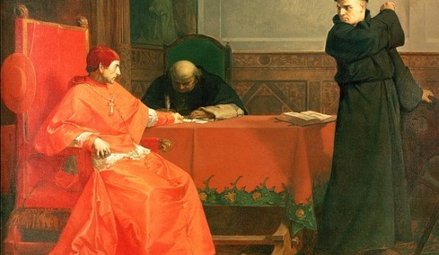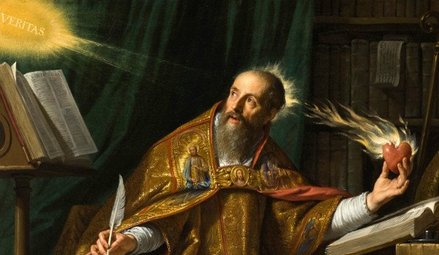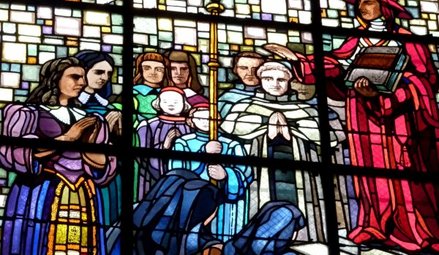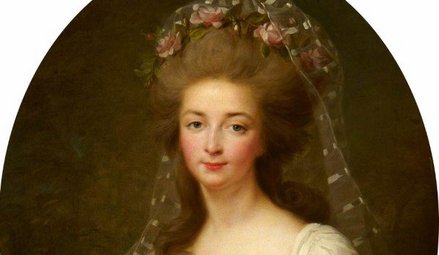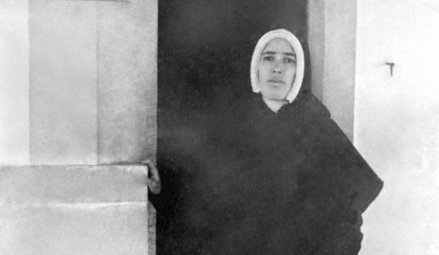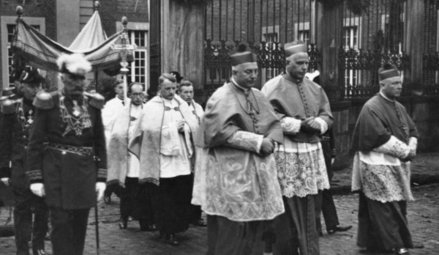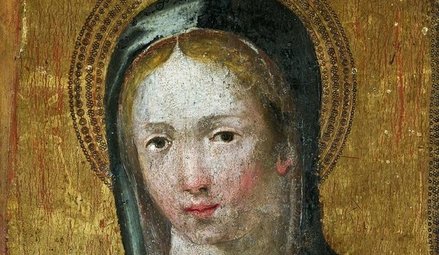- By theme
- Jesus
- The many proofs of Christ’s resurrection
- Saint Thomas Aquinas: God gave all the divine proofs we needed to believe
- The surpassing power of Christ's word
- Lewis’s trilemma: a proof of Jesus’s divinity
- God saves: the power of the holy name of Jesus
- Jesus spoke and acted as God's equal
- Jesus' divinity is actually implied in the Koran
- Jesus came at the perfect time of history
- Rabbinical sources testify to Jesus' miracles
- Mary
- The Church
- The Bible
- An enduring prophecy and a series of miraculous events preventing the reconstruction of the Temple
- The authors of the Gospels were either eyewitnesses or close contacts of those eyewitnesses
- Onomastics support the historical reliability of the Gospels
- The New Testament was not altered
- The New Testament is the best-attested manuscript of Antiquity
- The Gospels were written too early after the facts to be legends
- Archaeological finds confirm the reliability of the New Testament
- The criterion of embarrassment proves that the Gospels tell the truth
- The dissimilarity criterion strengthens the case for the historical reliability of the Gospels
- 84 details in Acts verified by historical and archaeological sources
- The unique prophecies that announced the Messiah
- The time of the coming of the Messiah was accurately prophesied
- The prophet Isaiah's ultra accurate description of the Messiah's sufferings
- Daniel's "Son of Man" is a portrait of Christ
- The Apostles
- Saint Peter, prince of the apostles
- Saint John the Apostle: an Evangelist and Theologian who deserves to be better known (d. 100)
- Saint Matthew, apostle, evangelist and martyr (d. 61)
- James the Just, “brother” of the Lord, apostle and martyr (d. 62 AD)
- Saint Matthias replaces Judas as an apostle (d. 63)
- The martyrs
- The protomartyr Saint Stephen (d. 31)
- Polycarp, bishop of Smyrna, disciple of John and martyr (d. 155)
- Saint Blandina and the Martyrs of Lyon: the fortitude of faith (177 AD)
- Saint Agatha stops a volcano from destroying the city of Catania (d. 251)
- Saint Lucy of Syracuse, virgin and martyr for Christ (d. 304)
- Thomas More: “The king’s good servant, but God’s first”
- The martyrdom of Paul Miki and his companions (d. 1597)
- The martyrs of Angers and Avrillé (1794)
- The Martyrs of Compiègne (1794)
- The Vietnamese martyrs Father Andrew Dung-Lac and his 116 companions (17th-19th centuries)
- He braved torture to atone for his apostasy (d. 1818)
- Blaise Marmoiton: the epic journey of a missionary to New Caledonia (d. 1847)
- José Luis Sanchez del Rio, martyred at age 14 for Christ the King (d. 1928)
- Saint Maximilian Kolbe, Knight of the Immaculate (d. 1941)
- The monks
- The Desert Fathers (3rd century)
- Saint Anthony of the Desert, a father of monasticism (d. 356)
- Saint Benedict, father of Western monasticism (d. 550)
- Saint Bruno the Carthusian (d.1101): the miracle of a hidden life
- Blessed Angelo Agostini Mazzinghi: the Carmelite with flowers pouring from his mouth (d. 1438)
- Monk Abel of Valaam's accurate prophecies about Russia (d. 1841)
- The more than 33,000 miracles of Saint Charbel Maklouf (d. 1898)
- Saint Pio of Pietrelcina (d. 1968): How God worked wonders through "a poor brother who prays"
- The surprising death of Father Emmanuel de Floris (d. 1992)
- The prophecies of Saint Paisios of Mount Athos (d. 1994)
- The saints
- Saints Anne and Joachim, parents of the Virgin Mary (19 BC)
- Saint Nazarius, apostle and martyr (d. 68 or 70)
- Ignatius of Antioch: successor of the apostles and witness to the Gospel (d. 117)
- Saint Gregory the Miracle-Worker (d. 270)
- Saint Martin of Tours: patron saint of France, father of monasticism in Gaul, and the first great leader of Western monasticism (d. 397)
- Saint Lupus, the bishop who saved his city from the Huns (d. 623)
- Saint Dominic of Guzman (d.1221): an athlete of the faith
- Saint Francis, the poor man of Assisi (d. 1226)
- Saint Anthony of Padua: "everyone’s saint"
- Saint Rose of Viterbo or How prayer can transform the world (d. 1252)
- Saint Simon Stock receives the scapular of Mount Carmel from the hands of the Virgin Mary
- The unusual boat of Saint Basil of Ryazan
- Saint Agnes of Montepulciano's complete God-confidence (d. 1317)
- The extraordinary conversion of Michelina of Pesaro
- Saint Peter Thomas (d. 1366): a steadfast trust in the Virgin Mary
- Saint Rita of Cascia: hoping against all hope
- Saint Catherine of Genoa and the Fire of God's love (d. 1510)
- Saint Anthony Mary Zaccaria, physician of bodies and souls (d. 1539)
- Saint Ignatius of Loyola (d. 1556): "For the greater glory of God"
- Brother Alphonsus Rodríguez, SJ: the "holy porter" (d. 1617)
- Martin de Porres returns to speed up his beatification (d. 1639)
- Virginia Centurione Bracelli: When God is the only goal, all difficulties are overcome (d.1651)
- Saint Marie of the Incarnation, "the Teresa of New France" (d.1672)
- St. Francis di Girolamo's gift of reading hearts and souls (d. 1716)
- Rosa Venerini: moving in the ocean of the Will of God (d. 1728)
- Seraphim of Sarov (1759-1833): the purpose of the Christian life is to acquire the Holy Spirit
- Camille de Soyécourt, filled with divine fortitude (d. 1849)
- Bernadette Soubirous, the shepherdess who saw the Virgin Mary (1858)
- Saint John Vianney (d. 1859): the global fame of a humble village priest
- Gabriel of Our Lady of Sorrows, the "Gardener of the Blessed Virgin" (d. 1862)
- Father Gerin, the holy priest of Grenoble (1863)
- Blessed Francisco Palau y Quer: a lover of the Church (d. 1872)
- Saints Louis and Zelie Martin, the parents of Saint Therese of Lisieux (d. 1894 and 1877)
- The supernatural maturity of Francisco Marto, “contemplative consoler of God” (d. 1919)
- Saint Faustina, apostle of the Divine Mercy (d. 1938)
- Brother Marcel Van (d.19659): a "star has risen in the East"
- Doctors
- The mystics
- Lutgardis of Tongeren and the devotion to the Sacred Heart
- Saint Angela of Foligno (d. 1309) and "Lady Poverty"
- Saint John of the Cross: mystic, reformer, poet, and universal psychologist (+1591)
- Blessed Anne of Jesus: a Carmelite nun with mystical gifts (d.1621)
- Catherine Daniélou: a mystical bride of Christ in Brittany
- Saint Margaret Mary sees the "Heart that so loved mankind"
- Mother Yvonne-Aimée of Jesus' predictions concerning the Second World War (1922)
- Sister Josefa Menendez, apostle of divine mercy (d. 1923)
- Edith Royer (d. 1924) and the Sacred Heart Basilica of Montmartre
- Rozalia Celak, a mystic with a very special mission (d. 1944)
- Visionaries
- Saint Perpetua delivers her brother from Purgatory (203)
- María de Jesús de Ágreda, abbess and friend of the King of Spain
- Discovery of the Virgin Mary's house in Ephesus (1891)
- Sister Benigna Consolata: the "Little Secretary of Merciful Love" (d. 1916)
- Maria Valtorta's visions match data from the Israel Meteorological Service (1943)
- Berthe Petit's prophecies about the two world wars (d. 1943)
- Maria Valtorta saw only one pyramid at Giza in her visions... and she was right! (1944)
- The 700 extraordinary visions of the Gospel received by Maria Valtorta (d. 1961)
- The amazing geological accuracy of Maria Valtorta's writings (d. 1961)
- Maria Valtorta's astronomic observations consistent with her dating system
- Discovery of an ancient princely house in Jerusalem, previously revealed to a mystic (d. 1961)
- The popes
- The great witnesses of the faith
- Saint Augustine's conversion: "Why not this very hour make an end to my uncleanness?" (386)
- Thomas Cajetan (d. 1534): a life in service of the truth
- Madame Acarie, "the servant of the servants of God" (d. 1618)
- Blaise Pascal (d.1662): Biblical prophecies are evidence
- Madame Élisabeth and the sweet smell of virtue (d. 1794)
- Jacinta, 10, offers her suffering to save souls from hell (d. 1920)
- Father Jean-Édouard Lamy: "another Curé of Ars" (d. 1931)
- Christian civilisation
- The depth of Christian spirituality
- John of the Cross' Path to perfect union with God based on his own experience
- The dogma of the Trinity: an increasingly better understood truth
- The incoherent arguments against Christianity
- The "New Pentecost": modern day, spectacular outpouring of the Holy Spirit
- The Christian faith explains the diversity of religions
- Cardinal Pierre de Bérulle (d.1629) on the mystery of the Incarnation
- Christ's interventions in history
- Marian apparitions and interventions
- The Life-giving Font of Constantinople
- Our Lady of Virtues saves the city of Rennes in Bretagne (1357)
- Mary stops the plague epidemic at Mount Berico (1426)
- Our Lady of Miracles heals a paralytic in Saronno (1460)
- Cotignac: the first apparitions of the Modern Era (1519)
- Savona: supernatural origin of the devotion to Our Lady of Mercy (1536)
- The Virgin Mary delivers besieged Christians in Cusco, Peru
- The victory of Lepanto and the feast of Our Lady of the Rosary (1571)
- The apparitions to Brother Fiacre (1637)
- The “aldermen's vow”, or the Marian devotion of the people of Lyon (1643)
- Our Lady of Nazareth in Plancoët, Brittany (1644)
- Our Lady of Laghet (1652)
- Saint Joseph’s apparitions in Cotignac, France (1660)
- Heaven confides in a shepherdess of Le Laus (1664-1718)
- Zeitoun, a two-year miracle (1968-1970)
- The Holy Name of Mary and the major victory of Vienna (1683)
- Heaven and earth meet in Colombia: the Las Lajas shrine (1754)
- The five Marian apparitions that traced an "M" over France, and its new pilgrimage route
- A series of Marian apparitions and prophetic messages in Ukraine since the 19th century (1806)
- "Consecrate your parish to the Immaculate Heart of Mary" (1836)
- At La Salette, Mary wept in front of the shepherds (1846)
- Our Lady of Champion, Wisconsin: the first and only approved apparition of Mary in the US (1859)
- Gietrzwald apparitions: heavenly help to a persecuted minority
- The silent apparition of Knock Mhuire in Ireland (1879)
- Mary "Abandoned Mother" appears in a working-class district of Lyon, France (1882)
- The thirty-three apparitions of the Virgin Mary in Beauraing (1932)
- "Our Lady of the Poor" appears eight times in Banneux (1933)
- Fontanelle-Montichiari apparitions of Our Lady "Rosa Mystica" (1947)
- Mary responds to the Vows of the Polish Nation (1956)
- Zeitoun apparitions
- The Virgin Mary comes to France's rescue by appearing at L'Ile Bouchard (1947)
- Maria Esperanza Bianchini and Mary, Mary, Reconciler of Peoples and Nations (1976)
- Luz Amparo and the El Escorial apparitions
- The extraordinary apparitions of Medjugorje and their worldwide impact
- The Virgin Mary prophesied the 1994 Rwandan genocide (1981)
- Our Lady of Soufanieh's apparition and messages to Myrna Nazzour (1982)
- The Virgin Mary heals a teenager, then appears to him dozens of times (1986)
- Seuca, Romania: apparitions and pleas of the Virgin Mary, "Queen of Light" (1995)
- Angels and their manifestations
- Mont Saint-Michel: Heaven watching over France
- Angels give a supernatural belt to the chaste Thomas Aquinas (1243)
- The constant presence of demons and angels in the life of St Frances of Rome (d. 1440)
- Mother Yvonne-Aimée escapes from prison with the help of an angel (1943)
- Saved by Angels: The Miracle on Highway 6 (2008)
- Exorcisms in the name of Christ
- A wave of charity unique in the world
- Saint Peter Nolasco: a life dedicated to ransoming enslaved Christians (d. 1245)
- Saint Angela Merici: Christ came to serve, not to be served (d. 1540)
- Saint John of God: a life dedicated to the care of the poor, sick and those with mental disorders (d. 1550)
- Saint Camillus de Lellis, reformer of hospital care (c. 1560)
- Blessed Alix Le Clerc, encouraged by the Virgin Mary to found schools (d. 1622)
- Saint Vincent de Paul (d. 1660), apostle of charity
- Marguerite Bourgeoys, Montreal's first teacher (d. 1700)
- Frédéric Ozanam, inventor of the Church's social doctrine (d. 1853)
- Damian of Molokai: a leper for Christ (d. 1889)
- Pier Giorgio Frassati (d.1925): heroic charity
- Saint Dulce of the Poor, the Good Angel of Bahia (d. 1992)
- Mother Teresa of Calcutta (d. 1997): an unshakeable faith
- Heidi Baker: Bringing God's love to the poor and forgotten of the world
- Amazing miracles
- The miracle of liquefaction of the blood of St. Januarius (d. 431)
- The miracles of Saint Anthony of Padua (d. 1231)
- Saint Pius V and the miracle of the Crucifix (1565)
- Saint Philip Neri calls a teenager back to life (1583)
- The resurrection of Jérôme Genin (1623)
- Saint Francis de Sales brings back to life a victim of drowning (1623)
- Saint John Bosco and the promise kept beyond the grave (1839)
- The day the sun danced at Fatima (1917)
- Pius XII and the miracle of the sun at the Vatican (1950)
- When Blessed Charles de Foucauld saved a young carpenter named Charle (2016)
- Reinhard Bonnke: 89 million conversions (d. 2019)
- Miraculous cures
- The royal touch: the divine thaumaturgic gift granted to French and English monarchs (11th-19th centuries)
- With 7,500 cases of unexplained cures, Lourdes is unique in the world (1858-today)
- Our Lady at Pellevoisin: "I am all merciful" (1876)
- Mariam, the "little thing of Jesus": a saint from East to West (d.1878)
- Gemma Galgani: healed to atone for sinners' faults (d. 1903)
- The miraculous cure of Blessed Maria Giuseppina Catanea
- The extraordinary healing of Alice Benlian in the Church of the Holy Cross in Damascus (1983)
- The approved miracle for the canonization of Juan Diego Cuauhtlatoatzin (1990)
- Healed by St Charbel Makhlouf, her scars bleed each month for the benefit of unbelievers (1993)
- The miracle that led to Brother André's canonisation (1999)
- Bruce Van Natta's intestinal regrowth: an irrefutable miracle (2007)
- He had “zero” chance of living: a baby's miraculous recovery (2015)
- Manouchak, operated on by Saint Charbel (2016)
- How Maya was cured from cancer at Saint Charbel's tomb (2018)
- Preserved bodies of the saints
- Dying in the odour of sanctity
- The body of Saint Cecilia found incorrupt (d. 230)
- Stanislaus Kostka's burning love for God (d. 1568)
- Blessed Antonio Franco, bishop and defender of the poor (d. 1626)
- The incorrupt body of Marie-Louise Nerbollier, the visionary from Diémoz (d. 1910)
- The great exhumation of Saint Charbel (1950)
- Bilocations
- Inedias
- Levitations
- Lacrimations and miraculous images
- Saint Juan Diego's tilma (1531)
- The Rue du Bac apparitions of the Virgin Mary to St. Catherine Labouré (Paris, 1830)
- Mary weeps in Syracuse (1953)
- Teresa Musco (d.1976): salvation through the Cross
- Soufanieh: A flow of oil from an image of the Virgin Mary, and oozing of oil from the face and hands of Myrna Nazzour (1982)
- The Saidnaya icon exudes a wonderful fragrance (1988)
- Our Lady weeps in a bishop's hands (1995)
- Stigmates
- The venerable Lukarda of Oberweimar shares her spiritual riches with her convent (d. 1309)
- Florida Cevoli: a heart engraved with the cross (d. 1767)
- Blessed Maria Grazia Tarallo, mystic and stigmatist (d. 1912)
- Saint Padre Pio: crucified by Love (1918)
- Elena Aiello: "a Eucharistic soul"
- A Holy Triduum with a Syrian mystic, witnessing the sufferings of Christ (1987)
- A Holy Thursday in Soufanieh (2004)
- Eucharistic miracles
- Lanciano: the first and possibly the greatest Eucharistic miracle (750)
- A host came to her: 11-year-old Imelda received Communion and died in ecstasy (1333)
- Faverney's hosts miraculously saved from fire
- A tsunami recedes before the Blessed Sacrament (1906)
- Buenos Aires miraculous host sent to forensic lab, found to be heart muscle (1996)
- Relics
- The Veil of Veronica, known as the Manoppello Image
- For centuries, the Shroud of Turin was the only negative image in the world
- The Holy Tunic of Argenteuil's fascinating history
- Saint Louis (d. 1270) and the relics of the Passion
- The miraculous rescue of the Shroud of Turin (1997)
- A comparative study of the blood present in Christ's relics
- Jews discover the Messiah
- Francis Xavier Samson Libermann, Jewish convert to Catholicism (1824)
- Our Lady of the Miraculous Medal and the conversion of Alphonse Ratisbonne (1842)
- Max Jacob: a liberal gay Jewish artist converts to Catholicism (1909)
- Edith Stein - Saint Benedicta of the Cross: "A daughter of Israel who, during the Nazi persecutions, remained united with faith and love to the Crucified Lord, Jesus Christ, as a Catholic, and to her people as a Jew"
- Patrick Elcabache: a Jew discovers the Messiah after his mother is miraculously cured in the name of Jesus
- Cardinal Aron Jean-Marie Lustiger (d. 2007): Chosen by God
- Muslim conversions
- Buddhist conversions
- Atheist conversions
- The conversion of an executioner during the Terror (1830)
- God woos a poet's heart: the story of Paul Claudel's conversion (1886)
- Dazzled by God: Madeleine Delbrêl's story (1924)
- C.S. Lewis, the reluctant convert (1931)
- The day André Frossard met Christ in Paris (1935)
- MC Solaar's rapper converts after experiencing Jesus' pains on the cross
- Father Sébastien Brière, converted at Medjugorje (2003)
- Franca Sozzani, the "Pope of fashion" who wanted to meet the Pope (2016)
- Nelly Gillant: from Reiki Master to Disciple of Christ (2018)
- Testimonies of encounters with Christ
- Near-death experiences (NDEs) confirm Catholic doctrine on the Four Last Things
- The NDE of Saint Christina the Astonishing, a source of conversion to Christ (1170)
- Jesus audibly calls Alphonsus Liguori to follow him (1723)
- Blessed Dina Bélanger (d. 1929): loving God and letting Jesus and Mary do their job
- Gabrielle Bossis: He and I
- André Levet's conversion in prison
- Journey between heaven and hell: a "near-death experience" (1971)
- Alicja Lenczewska: conversations with Jesus (1985)
- Vassula Ryden and the "True Life in God" (1985)
- Nahed Mahmoud Metwalli: from persecutor to persecuted (1987)
- The Bible verse that converted a young Algerian named Elie (2000)
- Invited to the celestial court: the story of Chantal (2017)
- Providential stories
- The superhuman intuition of Saint Pachomius the Great
- Germanus of Auxerre's prophecy about Saint Genevieve's future mission, and protection of the young woman (446)
- Seven golden stars reveal the future location of the Grande Chartreuse Monastery (1132)
- The supernatural reconciliation of the Duke of Aquitaine (1134)
- Saint Zita and the miracle of the cloak (13th c.)
- Joan of Arc: "the most beautiful story in the world"
- John of Capistrano saves the Church and Europe (1456)
- A celestial music comforts Elisabetta Picenardi on her deathbed (d. 1468)
- Gury of Kazan: freed from his prison by a "great light" (1520)
- The strange adventure of Yves Nicolazic (1623)
- Julien Maunoir miraculously learns Breton (1626)
- Pierre de Keriolet: with Mary, one cannot be lost (1636)
- How Korea evangelized itself (18th century)
- A hundred years before it happened, Saint Andrew Bobola predicted that Poland would be back on the map (1819)
- The prophetic poem about John Paul II (1840)
- Don Bosco's angel dog: Grigio (1854)
- Thérèse of Lisieux saved countless soldiers during the Great War
- Lost for over a century, a Russian icon reappears (1930)
- In 1947, a rosary crusade liberated Austria from the Soviets (1946-1955)
- The discovery of the tomb of Saint Peter in Rome (1949)
- He should have died of hypothermia in Soviet jails (1972)
- God protects a secret agent (1975)
- Flowing lava stops at church doors (1977)
- A protective hand saved John Paul II and led to happy consequences (1981)
- Mary Undoer of Knots: Pope Francis' gift to the world (1986)
- Edmond Fricoteaux's providential discovery of the statue of Our Lady of France (1988)
- The Virgin Mary frees a Vietnamese bishop from prison (1988)
- The miracles of Saint Juliana of Nicomedia (1994)
- Global launch of "Pilgrim Virgins" was made possible by God's Providence (1996)
- The providential finding of the Mary of Nazareth International Center's future site (2000)
- Syrian Monastery shielded from danger multiple times (2011-2020)
- Jesus
- Who are we?
- Make a donation
TOUTES LES RAISONS DE CROIRE
Les grands témoins de la foi
n°185
Pailly, Troyes and La Courneuve (France)
1853-1931
Father Jean-Édouard Lamy: "another Curé of Ars"
A French priest, Jean-Édouard Lamy, nicknamed the "second Curé of Ars" (in the words of Cardinal Léon Amette, Archbishop of Paris), was a model priest and a mystic, who regulary saw Mary and the angels. His apostolate among the poorest of the poor, the "ragpickers" of La Courneuve, is exemplary in every way. Those who knew him, especially his parishioners, testify that a supernatural energy inhabited this priest who was illuminated by charity. He returned to God on 1 December 1931.
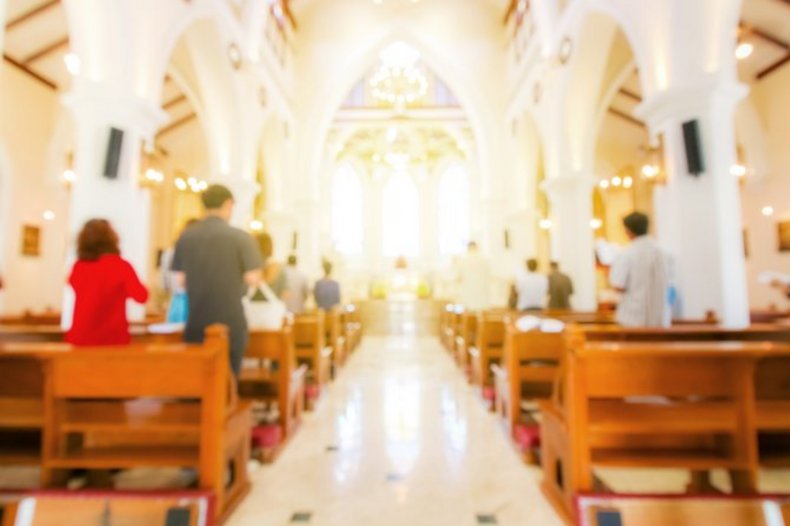
Les raisons d'y croire :
- The Virgin appeared to him at unexpected times. Of particular note is the apparition of 9 September 1909, which took place while he was celebrating Mass in the presence of several other people who perceived the great turmoil in which he was immersed. This apparition is of great importance: it is one of the few times since the Middle Ages that a dialogue between the Mother of God and Satan has been reported.
- No one has ever detected the slightest theological, doctrinal, moral or liturgical error in the content of these apparitions.
In 1932-1933, Monsignor Moissonnier, Vicar General of Langres (France, Haute-Marne), wrote a critical text on Father Lamy's revelations, but never disputed the parish priest's immense piety, and admitted that he had received "choice gracesfrom the Virgin, perhaps sometimes of an external nature, but in any case certain intimate communications."
- What's more, the cure he received at the shrine of Notre-Dame de Gray on 2 September 1882 is completely inexplicable: the serious skin condition he had contracted while sleeping on soiled sheets (he was in the army at the time) disappeared without any medical treatment or surgery.
Jean-Édouard Lamy was considered a saint during his lifetime. For instance, one day, while Fr. Lamy was having lunch at some friends' house, the maid discreetly cut a lock of his hair, which was successfully preserved in an envelope bearing the words: "Easter Wednesday, 7 April 1926, Mary cut off a lock of the holy priest's hair while serving us at table..."
- His former parishioners spontaneously formed an association, and prayer groups were organised to have their parish priest's sanctity canonically recognised.
- Father Lamy was an exceptional parish priest. The administration of the temporal goods and the elevation of the souls of the various parishes that were successively entrusted to him would obviously not have been possible if this man had not had many human qualities and virtues.
- His superhuman pastoral zeal must also be emphasised: for example, at La Courneuve, in two years, the number of communicants rose from 100 to 400.
Synthèse :
Jean-Edouard Lamy was born in Le Pailly, thirty kilometres south of Langres (France, Haute-Marne) on 22 June 1853, into a family of modest craftsmen (his father was a bricklayer). His great-grandparents had hidden refractory priests during the French Revolution, and their memories haunted the young boy's imagination. He grew up in material poverty, but in a loving family. He was not a very good student, preferring to walk in the countryside and go to the markets rather than study at his village primary school.
On the other hand, he was a pious boy who soon earned the nickname "the boy with the rosary". He gladly attended ceremonies and heard mass. One day he was able to become an altar boy and fulfilled this role to perfection. From an early age, he had a great devotion to the Virgin Mary, and spent whole nights in prayer before the statue of Mary Immaculate. He was eleven when the Mother of God appeared to him for the first time, while he was in a field looking after his parents' two cows. From then on, he resolved to become a priest.
In 1875, he did his military service, which lasted three and a half years. He was asked to look after the "military circle" library, and when their chaplain, Abbé Henri Nicole, founded the "Legion of Saint-Maurice", Lamy was told to act as a spiritual guide to young soldiers. He was promoted to the rank of sergeant, but deep down he felt that a career in the army was not for him. Some friends told him about a religious group to which they belonged: the Oblates of Saint Francis de Sales, in Troyes (France, Aube). They persuaded him to join them, which he accepted. It was a turning point in his Christian life.
He left his family on 1 September 1879, determined to earn a decent living and, above all, to serve Jesus. His first job was as an assistant at the Œuvre de la jeunesse, a kind of patronage aimed at helping young people who were sometimes away from the Church to live a Christian life. He thus discovered the missionary meaning of his existence.
At the same time, he studied at the Oblate studium, but had little success in his exams: "I studied when I could, and I was only free at night. My education was barely primary. And I had two courses: one in theology and one in Latin", he would later confide. His novitiate lasted more than two and a half years. Like the Curé of Ars, Father Lamy never showed any real taste for books.
Some days, he was even discouraged. But one evening in March 1884, he went into the chapel to meditate for a while. Kneeling on a bench, Saint Joseph appeared to him, "standing on the floor, by the first pillar, on the right, at the entrance[...], emitting his own light", he said. Saint Joseph stared at him and said a few words that penetrated the mind and heart of the future priest: "Be a priest. Be a good priest. You will become a good priest."At first he wondered whether he had been the victim of an illusion, and he went round the chapel, looking everywhere for some clue. "Everything was locked; that way I was sure I wasn't being fooled by an illusion", he would explain years later. Like any true private revelation, St Joseph's message remained etched on the young man's memory and will. He later testified: "Without St Joseph's intervention, I would not have become a priest."
He received minor orders on 21 March 1885 and, after making his religious profession and completing his studies in philosophy and theology, was ordained a priest on 12 December 1886. As soon as he was ordained, the Oblates appointed him director of their Work. He reorganised it, and the fruits of his apostolate with teenagers were soon many and varied: a return to the practice of religion, conversions, mutual respect, and so on. Father Lamy was the new "parish priest for hoodlums", as he was known at the time. His popularity soared, as he was fully committed to defending his young people, not hesitating to defend some of them in court.
At the same time, he led a hectic life and, what's more, God blessed him with incredible mystical gifts: visions, prophecies, knowledge and so on. He wore out his health prematurely, sleeping too little and eating poorly. His superiors then sent him to Guéret (France, Creuse) where they wanted to found a new Work after receiving a new property. Father Lamy, very much alone at the time in a region he knew nothing about, was nevertheless appointed vicar of the parish of Guéret. There, he devoted himself unstintingly to the souls and bodies of his parishioners, the poor and young people in particular.
In 1892, he was sent as pastor to Saint-Ouen (near Paris). There he set up patronages to bring together young people from different backgrounds, and radically overhauled catechism classes. He was then appointed parish priest in the diocese of Paris. He ceased to be an Oblate, while "remaining attached at heart" to his congregation.
On 14 September 1900, Father Lamy moved to La Courneuve (France, Seine-Saint-Denis). He dedicated his parish to the Immaculate Heart of Mary and founded the Confraternities of the Sacred Heart and the Heart of Mary, telling his parishioners, mostly workers and market gardeners whom he called his "foot soldiers": "If God, in his anger, were to break up the world, Mary would bring him back the pieces!"
His pastoral zeal was superhuman: as the only priest for a population of 23,000 inhabitants, he never gave up or took time off, day and night, taking communion to the sick, visiting families, baptising, confessing, administering the sacrament of the sick, etc. To help the poorest, he founded the "Dressing Room of the Child Jesus", a kind of mutual aid centre where people gave food and clothing. The number of members quadrupled in just a few years, from 100 in September 1900, to 400 two years later. When the First World War broke out, he was confessing thousands of soldiers passing through La Courneuve station, assisting the dying, burying the dead and so on. "At Easter, I was overwhelmed, I had up to a thousand Easter confessions. Sometimes I had to confess two hundred priests who came back in batches...".
On Thursday 9 September 1909, while on pilgrimage to Gray (France, Haute-Saône), the Virgin Mary appeared to him while he was celebrating Mass. He remembered the moment perfectly: it was between the end of the Gloria and the beginning of the offertory: "My attention was suddenly drawn to a great light coming from the vault on the Epistle side [...]. Immediately the light opened, and a woman seated in the light appeared. She was dressed in a dark blue robe, her head covered with a small white veil ". Behind Mary, he saw a "very stern-looking figure, his hair proudly pulled back over his forehead", who made him uneasy. The Mother of God and this figure then approached the altar. Mary's right hand touched Father Lamy's chasuble, and he in turn was enveloped in light. He noticed that the mysterious figure was somewhat removed from the marvellous light. He would remain so for the rest of the vision. The scene had three exceptional features:
- Mary appeared with the devil: not that she had come with him (she began by expressing surprise at his presence), but Satan showed up slightly behind her, giving his physical position a theological meaning.
- In addition, a dialogue took place between Mary and the devil, which Father Lamy heard. These words had high doctrinal meaning, such as this exchange: "The devil, addressing the Blessed Virgin, said to her: 'You are so perfect that you can equal yourself with God. The Blessed Virgin replied, "I am like you, a creature of God, but by a special privilege I have become his Mother."
- The Virgin asked the priest to continue his Mass, which he managed to do despite his emotion. He realised that the Virgin Mary followed the liturgy very closely: during the recitation of the Creed at the Incarnatus est ("He became man") she bowed her head as a sign of respect.
The first account of this event dates from 1910, just a few months after it occurred. Father Lamy would later write other versions, in 1917, 1918, and 1926, all in agreement.
During the apparition, the Virgin asked him to set up a pilgrimage to the isolated, poor chapel of Our Lady of the Woods, near Violot, in Haute-Marne, close to the village where he was born, "because," she told him, "they have nothing in those parts". She also showed him the statue he was to put there and the house that would serve as the chapel. Finally, she asked him to found a religious congregation. Each of her wishes was fulfilled in a very short time, even though nothing had been planned ahead!
Shortly afterwards, Father Lamy learned that a house was for sale in the Violot area. With the help of donations from his parishioners, he bought it. In January 1913, he spotted the statue he had seen during the apparition, in a shop in Paris. On 20 April 1914, the newly acquired house was blessed, becoming the chapel of the future community. Father Lamy celebrated the first mass there on 14 June 1922.
In the meantime, the ragpickers' priest had befriended Jacques and Raïssa Maritain (a Catholic married couple who are being considered for canonization. Jacques was a Catholic philosopher and Raïssa a poet and philosopher) who would defend his memory so much. Their mutual friend, Count Paul Biver, Fr. Lamy's future biographer, helped him to found the Congregation of the Servants of Jesus and Mary, at the request of the Virgin Mary. At the age of seventy-seven, Biver became the first Superior General.
Welcomed by Bishop Nègre of Tours, Fr. Lamy settled with a few volunteers in Chambourg (France, Indre-et-Loire) in 1930. The first few months were difficult due to indiscipline, strained relations, and lack of piety. Fr. Lamy was disappointed, as he tried every day to "put a little love of God into souls". In the end, he left Chambourg the following year. The congregation was in dire straits, but Father Lamy remained serene, even though he was morally affected:"I'm at peace, but that doesn't stop me from suffering."
He gave up his soul to God on 1 December 1931, during a visit to his friend Count Biver in Jouy-en-Josas.
Patrick Sbalchiero
Au-delà des raisons d'y croire :
Father Lamy was parish priest totally devoted to his parishioners, open to the intellectuals and artistic movements of his time, founder of pilgrimages and a patronage for young people, and author of spiritual writings. He is a model of spirituality and a giant of charity.
Aller plus loin :
Yves Chiron, Le Père Lamy. Un itinéraire mystique et missionnaire, Paris, Artège, 2021.
En savoir plus :Cent pensées du Père Lamy: Suivies du récit inédit de la visite de la Vierge à Gray le 9 septembre 1909, by Jean-Edouard Lamy and Yves Chiron, VIA ROMANA (November 25, 2021)
- Jacques Maritain, "Notice nécrologique.M. l'abbé Éd.Lamy, ancien curé de La Courneuve", La Semaine religieuse de Paris, 20 February 1932, pp. 281-283.
- Paul Biver, Apôtre et mystique : le père Lamy,Paris, Gabriel Énault, 1933.
- Daniel-Rops, Histoire de l'Église du Christ, t. 6, vol. 2, Un combat pour Dieu, Paris, Fayard, 1963, p. 789-792.
- On the Prophecies for Our Time website, the article " Père Jean-Édouard Lamy (1853 - 1931) : "la paix sera rendue au monde".
- On the Notre Histoire avec Marie website, the article " Le père Lamy : Marie en toute simplicité".
- The Aleteia article: " Father Lamy, saved from the bombings... by his guardian angel".
Cent pensées du Père Lamy: Suivies du récit inédit de la visite de la Vierge à Gray le 9 septembre 1909, by Jean-Edouard Lamy and Yves Chiron, VIA ROMANA (November 25, 2021)









